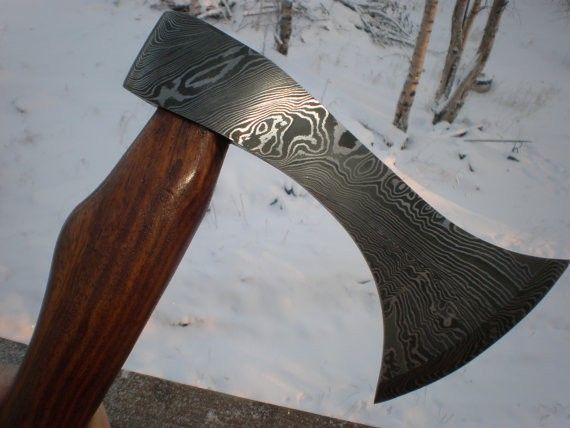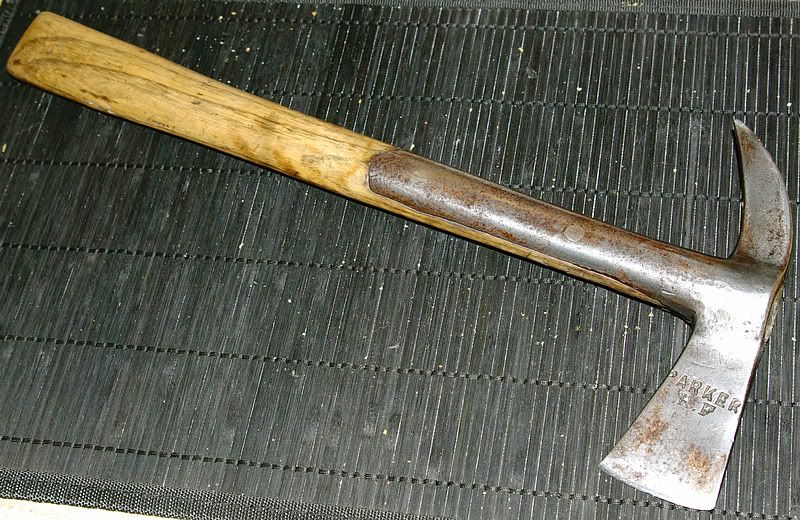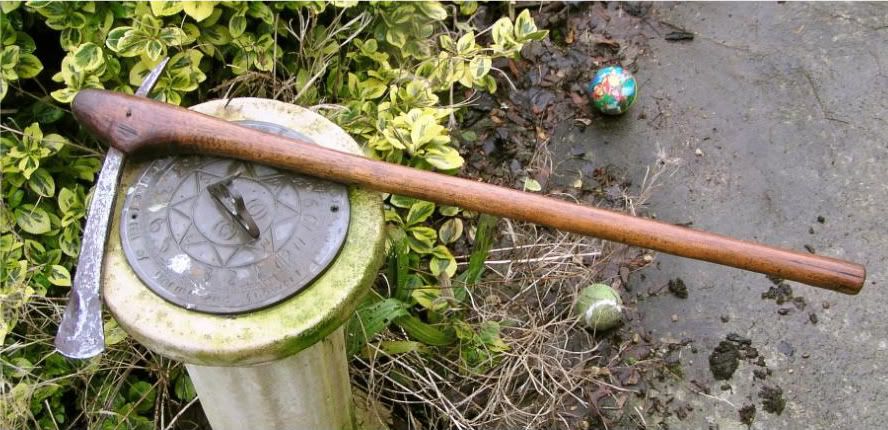
 |
|
|
#1 |
|
Member
Join Date: Dec 2004
Location: NC, U.S.A.
Posts: 2,100
|
Here is my meager collection of colonial-era axes...
|
|
|

|
|
|
#2 |
|
Member
Join Date: Dec 2004
Location: NC, U.S.A.
Posts: 2,100
|
Here is a nice spike tomahawk, ca 1780-1830. Spike axes were traded with the native Americans and quite popular. This one has a single-bearded blade, no steel bit, original old haft and a blacksmith repair in its working life. (Often a blacksmith/fur trader lived near the tribe to trade. There are several examples of repaired axes in Hartzler's book), Note the squared notch cut into the blade later. It is not a nail-pull, but used by trappers as a trap chain pull (you go sticking your hand in frigid water all day and see why they did this to the axe!). Old brownish-red primer and deadly spike.
Last edited by M ELEY; 22nd March 2010 at 01:15 AM. |
|
|

|
|
|
#3 |
|
Member
Join Date: Dec 2004
Location: NC, U.S.A.
Posts: 2,100
|
Here we have that boarding axe again! This time hopefully with better pics...
|
|
|

|
|
|
#4 |
|
Member
Join Date: Dec 2004
Location: NC, U.S.A.
Posts: 2,100
|
This is what they call the 1st Pattern of rifleman's axe, ca 1760-1800. It has a very hefty head and original haft. The later versions had slight differences. Note that with these early hammer polls, it is generally theorized that the "hammer" was actually more of a balancing weight and allowed for a more powerful chop. This type carried by continental soldiers and explorers.
|
|
|

|
|
|
#5 |
|
Member
Join Date: Dec 2004
Location: NC, U.S.A.
Posts: 2,100
|
This is a Revolutionary War camp axe as distributed to the continental soldiers (the Yankee Doodle Dandies, as the Tories used to call them). The haft is perhaps walnut? An example in Hartzler's book is a dead-on match for this one. It has an unreadable stamping on the blade. Well, I had one more little spike axe, but I've lost the pictures, so that's all folks!
Last edited by M ELEY; 22nd March 2010 at 01:14 AM. |
|
|

|
|
|
#6 |
|
Arms Historian
Join Date: Dec 2004
Location: Route 66
Posts: 9,951
|
Absolutely outstanding post Mark!!! A grouping of such weapons does not need to be voluminous, especially when they well illustrate the distinctions of a weapon form and its variations. What is best is that you offer important information along with the illustrations, and give us all a chance to learn more on these axes.
This is exactly what I always hope for, information, description and explanation along with weapons illustrated. Well done, and thank you so much!!!  All the very best, Jim |
|
|

|
|
|
#7 |
|
Member
Join Date: Dec 2004
Location: NC, U.S.A.
Posts: 2,100
|
Thanks Jim. Now that I'm getting a little better with posting pics, just thought I'd try my hand with the axe pics. So glad you enjoyed them. It seems to be one of the last areas of collecting where one can still occasionally get a bargain now and then.
|
|
|

|
|
|
#8 |
|
Member
Join Date: Dec 2009
Posts: 140
|
Hi,
you are right. I think axes are a differnt field of ethnographis, where less peope deal with. whats the title of the book you mentioned ? So you know alredy my beheading axe, now i added some more. from left a german fire axe second i will call india or persia third i could not identify, no marks, maybe a smiths homework the head should be a celtic on from around 300 and the last one is a normal carpenter axe if any one needs close ups just shout all of you a happy day Dirk |
|
|

|
|
|
#9 |
|
Member
Join Date: Dec 2009
Posts: 140
|
to fast the little right finger ;-))
|
|
|

|
|
|
#10 |
|
Member
Join Date: Dec 2004
Location: NC, U.S.A.
Posts: 2,100
|
Hello Dirk,
Very nice collection. I especially like the Persian axe. The 3rd unidentified axe you have would be classified as a trade axe here in the States. As it is double-flaired, it would fall into the later 1800-1850 era. Nice original haft to it. The book I was referring to was "Indian Tomahawks and Frontiersmen's axes" by Hartzler and Knowles. A great book on the subject. While not as thorough, Neumann's "Swords and blades of the American Revolution" likewise has a nice collection of axes. |
|
|

|
|
|
#11 |
|
Member
Join Date: Nov 2008
Posts: 332
|
Junker, please post close-ups of your persian/india axe. From here it looks like an old replica of a franciska.
|
|
|

|
|
|
#12 |
|
Member
Join Date: Dec 2009
Posts: 140
|
Hi Broadaxe,
it is definitive no francisca, but may be a fake, i m not shure with this item. therefore i said "I will call it persian" I havent anything like this in my books. All suggestions are welcome Dirk |
|
|

|
|
|
#13 |
|
Member
Join Date: Nov 2008
Posts: 332
|
I have to argue that. It doesn't look like any Persian or Indian axe I know.
It does look like a Franciska to me, at least like an old replica, probably Victorian. I will look into my books. Please check also here: http://www.axtwerfen.de/_20010102-14...e143__ENGL.htm |
|
|

|
|
|
#14 |
|
Member
Join Date: Dec 2009
Posts: 140
|
Hi,
yes the shape is verry similar, but there would no decoration on a francisca. Victorian replica sounds interesting, if you got anything abaout that i would appreciate it Dirk |
|
|

|
|
|
#15 |
|
Member
Join Date: Jan 2012
Location: Wychwood Forest, Armidale NSW, New England Australia
Posts: 2
|
Nice collection you have there, thanks for sharing.
Regards. |
|
|

|
|
|
#16 |
|
Member
Join Date: Dec 2004
Location: NC, U.S.A.
Posts: 2,100
|
No problem, Keith. Welcome to the forum! Do you collect axes? I just lost out on a nice Danish boarding axe/entrebil recently
 . Hope to land one one day... . Hope to land one one day...Mark |
|
|

|
|
|
#17 |
|
Member
Join Date: Jul 2006
Location: Buraimi Oman, on the border with the UAE
Posts: 4,408
|
Salaams,
Nice. I had no idea that the Francisca were thrown in volleys in the assault to break up the enemy shields and cause general mayhem. My suspicion is that this is a francisca axe but a new one... used in the re enactment of mediaeval battles. The decoration is misleading and implies a tree of life design but I think this is just artistic licence as most francisca axes Ive seen are so corroded or worn that no original surface seems to have survived. Wiki encyclopedia says Quote "The francisca (or francesca) is a throwing axe used as a weapon during the Early Middle Ages by the Franks, among whom it was a characteristic national weapon at the time of the Merovingians from about 500 to 750 AD and is known to have been used during the reign of Charlemagne (768–814). Although generally associated with the Franks, it was also used by other Germanic peoples of the period including the Anglo-Saxons, and several examples have been found in England." Francisca on display in Romano-Germanic Museum in Cologne, Germany The term francisca first appeared in the book Ethymologiarum sive originum, libri XVIII by Isidore of Seville (c. 560–636) as a name used among the Spanish to refer to these weapons "because of their use by the Franks". The historian Gregory of Tours (c. 538–594) in his History of the Franks uses two Latin terms for the Frankish axe: securis and bipennis. The régime of Vichy France used the image of a stylised double-headed francisque as part of its iconography. The francisca is characterized by its distinctly arch-shaped head, widening toward the cutting edge and terminating in a prominent point at both the upper and lower corners. The top of the head is usually either S-shaped or convex with the lower portion curving inward and forming an elbow with the short wooden haft. Sometimes the head is more upswept forming a wider angle with the haft. Most franciscas have a round or teardrop-shaped eye designed to fit the tapered haft, similar to Viking axes. Based on the measurements of modern replicas the francisca had a haft length of around 40-45 cm (16-18 in) and a 10 cm (4 in) cutting edge with an average weight of around 600 g (21 oz, 1.3 lb).Based on surviving heads of franciscas recovered at Burgh Castle and Morning Thorpe in county Norfolk, England the length of the head itself measured 14-15 cm (5-6 in) from the edge to the back of the socket. The Roman historian Procopius (c. 500–565) described the Franks and their use of throwing axes: "...each man carried a sword and shield and an axe. Now the iron head of this weapon was thick and exceedingly sharp on both sides while the wooden handle was very short. And they are accustomed always to throw these axes at one signal in the first charge and thus shatter the shields of the enemy and kill the men...." Procopius makes it clear that the Franks threw their axes immediately before hand to hand combat with the purpose of breaking shields and disrupting the enemy line while possibly wounding or killing an enemy warrior. The weight of the head and length of the haft would allow the axe to be thrown with considerable momentum to an effective range of about 12 m (40 ft). Even if the edge of the blade were not to strike the target the weight of the iron head could cause injury. The Franks were not the first to utilize the Francisca. The Francisca was also used as an intimidator in that upon throwing of the Francisca, the enemy might turn and run in the fear that another volley was coming. Another feature of the francisca was the tendency to bounce unpredictably upon hitting the ground due to its weight, unique shape, lack of balance and slight curvature of the haft, making it difficult for defenders to block. It could rebound up at the legs of opponents or against shields and through the ranks. The Franks capitalized on this by throwing the franciscas in a volley in order to confuse, intimidate and disorganize the enemy lines either before or during a charge to initiate close combat. Today, the francisca remains in popular use as a throwing axe in competitions or as a weapon for reenactors of medieval warfare. "Unquote. Bold letters are mine. Diagrams and other information are on web at Wiki encyclopedia etc Regards, Ibrahiim al Balooshi. |
|
|

|
|
|
#18 |
|
Member
Join Date: Dec 2004
Location: NC, U.S.A.
Posts: 2,100
|
Fantastic information and a plethora of information, Ibrahiim. I'll have to take some time to 'digest' all of it.
BTW, welcome to THIS side of the forum for a change-  
|
|
|

|
|
|
#19 |
|
Member
Join Date: Dec 2009
Posts: 140
|
Hi,
thanks for the information about the francisca. But this seems to be an older copy. Maybe around 1880 ? I m not shure about this item at all. BTW here are some new inputs to my colection: One russin example with a double eagle and 1917 stamped on it. An forrester axe for marking the timber. and one which has a rising horse as a mark and some markings like: ?; Remscheid (town in germany); ?GO FUNDIDO, GARANTIDO; No 36B; 31 lbs. |
|
|

|
|
|
#20 | |
|
(deceased)
Join Date: Dec 2004
Location: Portugal
Posts: 9,694
|
Quote:
Probably an export lot for Portugal ... or Brazil ? |
|
|
|

|
|
|
#21 |
|
Member
Join Date: Dec 2009
Posts: 140
|
Hi Fernando,
yes that is my idea, too. I thougt of export to south america. But i found it here in germany. I have read that some articles which was expected to be shipped to south america were canceled in the 1940 th. (This item werde knifes, but axes will be the same ) Dirk |
|
|

|
|
|
#22 |
|
(deceased)
Join Date: Dec 2004
Location: Portugal
Posts: 9,694
|
Hi Dirk,
Being South America it has to be Brazil, the only Portuguese speaking country; the others speak Spanish and steel in Spanish is acero and not aço |
|
|

|
|
|
#23 |
|
Member
Join Date: Dec 2009
Posts: 140
|
Hi Fernando,
you are the master. I dont speak either portugese or spanish. (And my english is also worse, I know)  Dirk |
|
|

|
|
|
#24 |
|
Member
Join Date: Dec 2004
Location: NC, U.S.A.
Posts: 2,100
|
With all our talk on boarding axes, I'm dredging this one up again. In the third picture down from the top is the ax in question. I will say that I can't be sure if its cast or not. It appears to have some flaws one might call 'forging' flaws, but perhaps its just the cast. It is a heavy example with thick blade, spike and eye. The eye is rounded, in Brit style, while the front and rear langets more in the French and Scandinavian pattern. Blade is bearded, 4-sided spike. Note the langets are primitive, definitely blacksmith made, with rivet. The haft still has the lathe markings.
Anyway, I figured since we're been on the subject, it was time to open this one up for attack!! |
|
|

|
|
|
#25 |
|
Member
Join Date: Mar 2006
Location: Room 101, Glos. UK
Posts: 4,184
|
nice axes. sadly all mine are relatively recently forged.

|
|
|

|
|
|
#26 |
|
Member
Join Date: Dec 2004
Location: NC, U.S.A.
Posts: 2,100
|
Hi, Kronckew. That's a beautiful ax! Damascus looks great. How are you on boarding axes? I'm putting you in the line of fire, I suppose-
 
|
|
|

|
|
|
#27 |
|
Member
Join Date: Jan 2013
Location: Scotland
Posts: 330
|
Great to see so many axes and thanks Mark for starting the thread, I particularly like your spiked trappers tomahawk.
Possibly Junker or the group can answer a question for me concerning the fire axe the lower one in his picture. I have seen an almost identical one sold at auction as an 18/19th century German boarding axe and I have also seen it pictured as a German trench axe from WW1 on the net. Is it a German government model used across different services? I know these questions are not always easy to answer but it has puzzled me for a while. CC |
|
|

|
|
|
#28 |
|
Member
Join Date: Jan 2013
Location: Scotland
Posts: 330
|
Thanks Fernando - I have a machete/sword marked marked ACERO FUNDIDO, GARANTIZADO and now I know what it means. It is made by Esser in Germany I guess for export to Spanish S. America and also has a rearing horse symbol.
CC |
|
|

|
|
|
#29 | |
|
Member
Join Date: Mar 2006
Location: Room 101, Glos. UK
Posts: 4,184
|
Quote:
 my favourite antique axes:  african axe  fokos  bullova (moustache axe) just ordered this one today, kinda boarding axe-ish: 127 cm/2.4 kilos Last edited by kronckew; 1st March 2013 at 02:44 PM. |
|
|
|

|
|
|
#30 |
|
Member
Join Date: Nov 2008
Posts: 332
|
Just a small correction referring the fokos - technically it is a Polish ciupaga, and a very distinctive one, though it seems rather recent.
|
|
|

|
 |
|
|